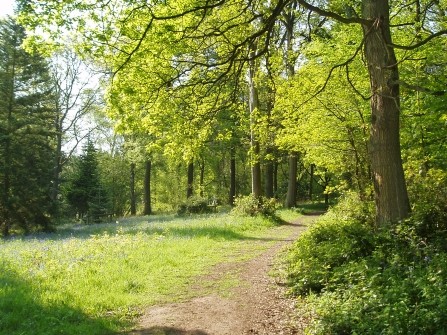Queenswood is such an asset to the Trust and, of course, to everyone who visits, walks their dog, or brings the children to play in the woods or the playground. The arboretum is the heart of the country park and includes many unusual and champion trees from all over the world, so for a tree lover like myself working here is such a pleasure and a privilege.
Over the last few decades the management of the arboretum has been in the hands of people with vision, with the skill to plan tree planting, bearing in mind the resulting growth and impact of maturing trees on each other and the existing surroundings. Bearing in mind the whole woodland was clear felled during the First World War means we have no veteran trees, the biggest oaks and beeches dating pre 1945, the youngest have just been planted, courtesy of the Coronation Fund who provide funds and expert advice.
I spent most of 30 years prior to 2000 as an organic Dairy Farmer in Eire and Wales and, after retreating from the milking parlour, happily found myself looking after woodland on the Hill Court Estate, near Ross. (Coincidentally it was Mrs. Trafford, from Hill Court who in 1934 made it possible to acquire Queenswood for the people of Herefordshire).
After retirement I wanted to use my woodland management skills on a volunteering basis, and was very happy to be taken on by Paul Ratcliff as a volunteer at Queenswood. This means that I do one day per week, arrive early on a Monday morning, and Paul and I do an appraisal of the jobs that need to be done.
One of the great strengths of Queenswood as an arboretum is that we have an excellent labelling system, which means that the visitor can understand exactly what tree they are looking at. I have travelled extensively around many arboretums, and been frustrated at not being able to identify a tree due to poor labelling; this does not happen at Queenswood. We put a lot of time into making sure all identification is kept to a high standard, we owe it to our visitors and to the generous sponsors who have dedicated a tree, possibly to a departed loved one.
Routine work includes clearing and cutting of dead branches which is most important as visitor numbers are high and falling dead wood can be dangerous. We put a lot of emphasis on clearing the ground of undergrowth like brambles, so that the visitor has maximum access to specimen trees. Mowing has to be carefully timed and managed so as to not interfere with ground nesting birds and wildflower growth. The younger trees in the collection are in wire cages, protected from marauding deer, so there is much to be done keeping the cages relatively tidy; weeding, replacing, removing and repairing cages takes up much of my time. Perimeter fencing is another of our responsibilities. Our trees sometimes fall on neighbouring ground, so we have to be vigilant; ‘good fences make good neighbours’! We also have to keep an eye on the outlying areas of woodland, and I sometimes lend a hand to the coppicing group who are working their way through areas of oak and hazel.
Another of our tasks at Queenswood is simply to keep an eye on the trees and their health, to walk around and take the time to do an appraisal of how different areas of the arboretum are shaping up and, like our predecessors, plan for future fellings and plantings.
So much of a farmers time can be spent planning for the future years, and the same is true in arboriculture. Past managers and tree planters have left us a marvellous legacy at Queenswood, so it is up to us to keep it all in good condition and make improvements for the future.
So, if you see me toiling away amongst the trees on a Monday, please feel free to stop and talk about the arboretum for at Queenswood we just love to talk about trees!

